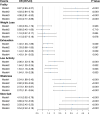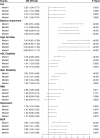Effects of cognitive ageing trajectories on multiple adverse outcomes among Chinese community-dwelling elderly population
- PMID: 35996087
- PMCID: PMC9396872
- DOI: 10.1186/s12877-022-03387-8
Effects of cognitive ageing trajectories on multiple adverse outcomes among Chinese community-dwelling elderly population
Abstract
Background: Whether cognitive ageing trajectory is related to common functional deficits independent of initial cognitive function remains inconclusive. We aimed to explore the adverse health effect and potential predictive factors of distinct cognitive trajectories among Chinese older adults.
Methods: Three thousand five hundred eighty-one community-dwelling older adults who completed three consecutive cognitive function examinations with the Mini-Mental State Examination (MMSE) over 5 years and were without cognitive impairment at enrollment were included. A group-based trajectory model was used to estimate cognitive ageing trajectories. Multivariable-adjusted odds ratio (OR) and 95% confidence intervals (CI) were computed with logistic regression models to identify potential baseline determinants and health effect of cognitive trajectories on various adverse outcomes.
Results: Two distinct cognitive ageing trajectories were identified with about 5.3% of the study participants ascribed to the rapidly decreasing group. Subjects with rapidly decreasing cognition showed significantly higher odds (OR, 95%CI) of experiencing frailty (4.04, 2.77-5.86), falls (2.01, 1.05-3.70), balance impairment (4.20, 2.75-6.38), high fall risk (5.66, 2.67-11.77) based on the Tinetti total score, disability in activities of daily living (1.76, 1.19-2.56), disability in instrumental activities of daily living (1.52, 1.05-2.19), and motor cognitive risk syndrome (2.24, 1.23-3.98) compared with their steadily decreasing counterparts. Individuals with older age, low education level, no marriage, high score of rapid eye movement behavior disorders, poor physical and cognitive function at baseline were more predisposed to an accelerated cognitive decline.
Conclusions: Faster cognitive decline was independently associated with higher risk of multiple adverse events. Our findings put more emphasis on a routine and constant surveillance of cognitive function among community-dwelling older adults.
Keywords: Ageing; Chinese; Cognitive decline; Functional deficits; Trajectory.
© 2022. The Author(s).
Conflict of interest statement
The authors have no conflicts of interest to declare.
Figures



Similar articles
-
Cognitive function in Prefrail and frail community-dwelling older adults in China.BMC Geriatr. 2019 Feb 27;19(1):53. doi: 10.1186/s12877-019-1056-8. BMC Geriatr. 2019. PMID: 30813907 Free PMC article.
-
Screening for frailty and its association with activities of daily living, cognitive impairment, and falls among community-dwelling older adults in China.BMC Geriatr. 2024 Jul 3;24(1):576. doi: 10.1186/s12877-024-05173-0. BMC Geriatr. 2024. PMID: 38961352 Free PMC article.
-
Visual trajectories and risk of physical and cognitive impairment among older Chinese adults.J Am Geriatr Soc. 2021 Oct;69(10):2877-2887. doi: 10.1111/jgs.17311. Epub 2021 Jun 10. J Am Geriatr Soc. 2021. PMID: 34111310
-
Oral frailty as a risk factor for mild cognitive impairment in community-dwelling older adults: Kashiwa study.Exp Gerontol. 2023 Feb;172:112075. doi: 10.1016/j.exger.2022.112075. Epub 2022 Dec 26. Exp Gerontol. 2023. PMID: 36581224 Review.
-
Cognitive effects of cancer and its treatments at the intersection of aging: what do we know; what do we need to know?Semin Oncol. 2013 Dec;40(6):709-25. doi: 10.1053/j.seminoncol.2013.09.006. Semin Oncol. 2013. PMID: 24331192 Free PMC article. Review.
Cited by
-
Can the Frailty of Older Adults in China Change? Evidence from a Random-Intercept Latent Transition Profile Analysis.Behav Sci (Basel). 2023 Aug 30;13(9):723. doi: 10.3390/bs13090723. Behav Sci (Basel). 2023. PMID: 37754001 Free PMC article.
-
Turning Point of Cognitive Decline for Chinese Older Adults from a Longitudinal Analysis: Protective Factors and Risk Factors.Healthcare (Basel). 2022 Nov 17;10(11):2304. doi: 10.3390/healthcare10112304. Healthcare (Basel). 2022. PMID: 36421628 Free PMC article.
-
Reading Holy Quran Associated With Better Cognitive Function in Older Adults: A Systematic Review.Gerontol Geriatr Med. 2024 Mar 18;10:23337214241239219. doi: 10.1177/23337214241239219. eCollection 2024 Jan-Dec. Gerontol Geriatr Med. 2024. PMID: 38505741 Free PMC article. Review.
-
Association Between Cognitive Trajectories and Subsequent Health Status, Depressive Symptoms, and Mortality Among Older Adults in the United States: Findings From a Nationally Representative Study.J Gerontol A Biol Sci Med Sci. 2024 Aug 1;79(8):glae143. doi: 10.1093/gerona/glae143. J Gerontol A Biol Sci Med Sci. 2024. PMID: 38845419 Free PMC article.
-
Association between social capital and trajectories of cognitive function among Chinese older adults.BMC Public Health. 2025 Jan 24;25(1):300. doi: 10.1186/s12889-025-21570-5. BMC Public Health. 2025. PMID: 39856630 Free PMC article.
References
-
- United Nations, world population ageing 2017 - highlights (ST/ESA/SER.A/397). Department of Economic and Socal Affairs, Population Division 2017.
-
- Jia L, Du Y, Chu L, Zhang Z, Li F, Lyu D, Li Y, Li Y, Zhu M, Jiao H, et al. Prevalence, risk factors, and management of dementia and mild cognitive impairment in adults aged 60 years or older in China: a cross-sectional study. Lancet Public Health. 2020;5(12):e661–e671. doi: 10.1016/S2468-2667(20)30185-7. - DOI - PubMed
Publication types
MeSH terms
LinkOut - more resources
Full Text Sources
Medical

